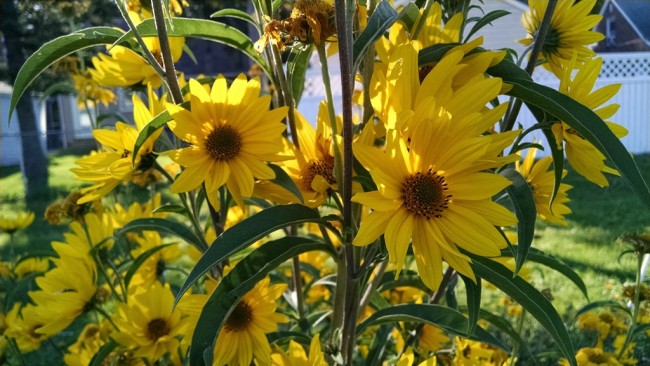
Dixon Branch Greenbelt Projects: Is it crazy to dream big?
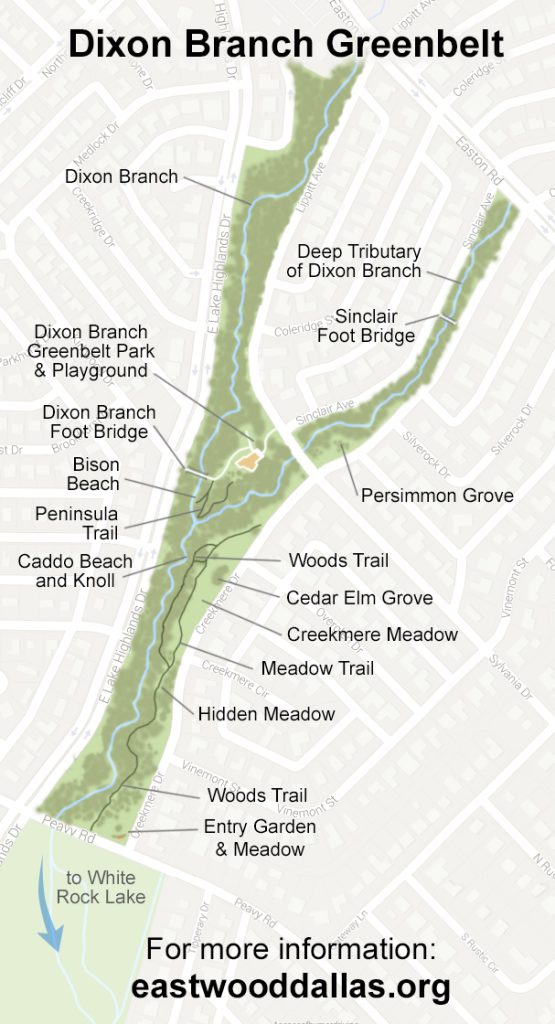
By Amy Martin, Greenbelt Guild coordinator
The Dixon Branch Greenbelt Guild stewards eight acres of Dallas Parks and Recreation riparian land in the Dixon Branch Greenbelt. This linear swath of riparian land flanks the Dixon Branch feeder of White Rock Lake. Located mainly along Creekmere between Peavy and Easton, our focus is the woods and meadows between Peavy and Sylvania.
- Greenbelt Guild webpage
- Greenbelt iNaturalist page
- N TX Master Naturalist note: VH is under Dallas Parks & Open Spaces. Include “Dixon Branch Greenbelt” in the comments.
Ecology
The greenbelt’s forested areas, mainly along the creek, have many mature hardwoods such as black walnut, cedar elm, hackberry and sugarberry. Some Shumard oak, as well as bois d’arc and pecan, are 80 years of age and up. Less common are catalpa, eastern red cedar, and gum bumelia.
Though plagued by Chinese and glossy leaf/big leaf privet and Amur honeysuckle, most of the forest remains healthy. The understory features Eve’s necklaces, an extensive stand of uncommon rusty blackhaw viburnums, and scattered coralberry, elbow bush, possumhaw, roughleaf dogwood, and yaupon. The herbaceous ground cover is dominated by river oats and Virgina wildrye, with goldenrod, Mexican petunia, and plentiful poison ivy.
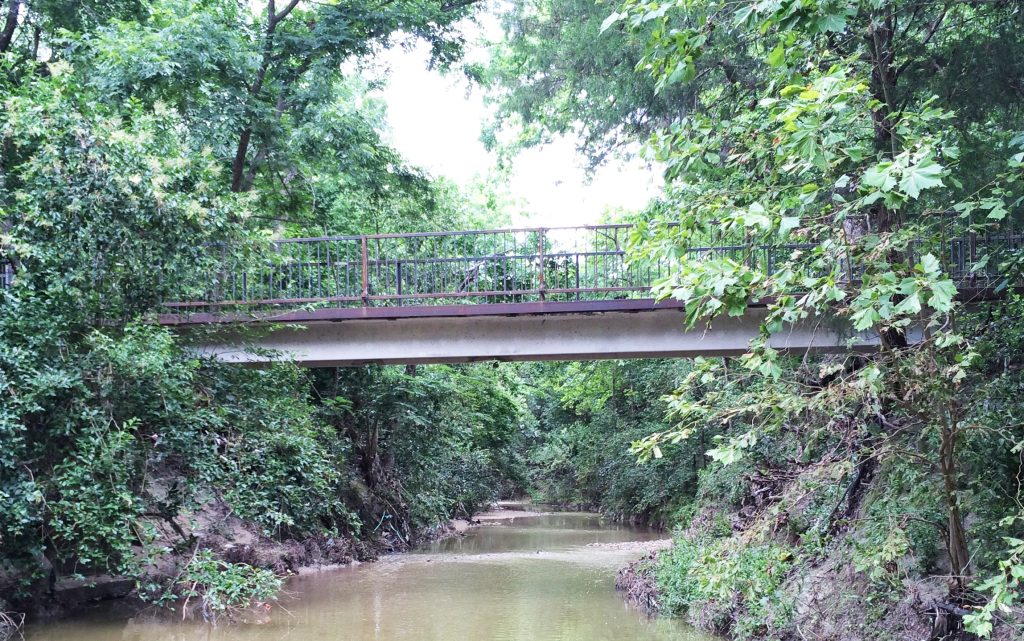
A-list projects from east to west:
Project A#1:
historic pecans & finding the Dixon Druid
Context: At the eastern end of the Creekmere Meadow Trail are a historic pecan next to the road and another one a little bit down the trail. In the woods behind the 2nd pecan (which backs up to a tributary of Dixon Branch that borders the playground) are several large hardwoods, possibly pecans.
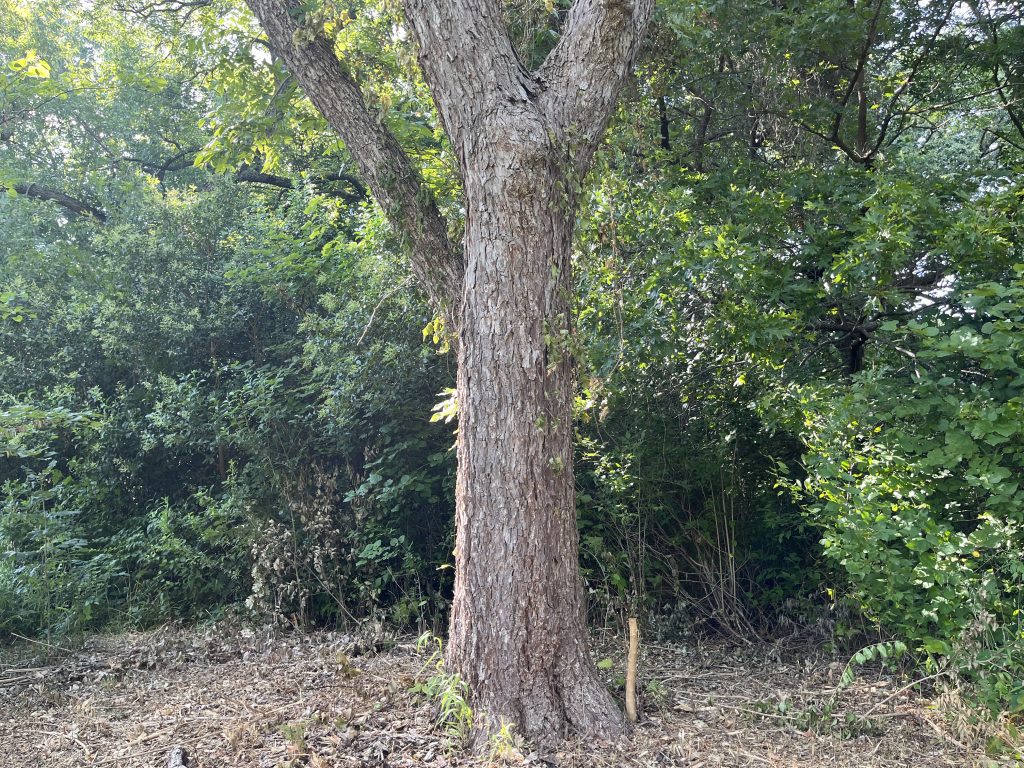
Somewhere in those woods is a two-foot statue of St Fransis of Assisi that’s been dubbed the Dixon Druid. Clueless as to how it got there or when. But let’s find it again! Also somewhere in there is a mature Chinese pistache that must die by girdling because it’s seeding the meadow.
Goal: Rejuvenate two historic pecans. The first pecan anchors a small triangular spot next to Creekmere that could be a real showplace for nature. Craft an open hardwood forest with varied understory as enhanced wildlife habitat, with a secret meditation spot.
Strategy: Continue quelling the Amur honeysuckle, poison ivy, and small and large-leaf privet beneath the pecans. In mid-fall, seed with native grasses and wildflowers, and plant beautyberry, coralberry, and pigeonberry. Begin pulling privet from behind the second pecan to get a gander past the privet curtain on the woods edge.
After poison ivy leaves drop in late fall, continue thinning and treating the privet curtain. Select some long straight privet trunks for project A#2 and make curb mounds of the rest. Find the druid! Assess the interior forest. Plant scattered black walnut and Eve’s necklace. Pull out any invasives.
Time: full workday (8 hrs) with lunch break plus maintenance
Project A#2:
re-route the eastern woods trail away from creek
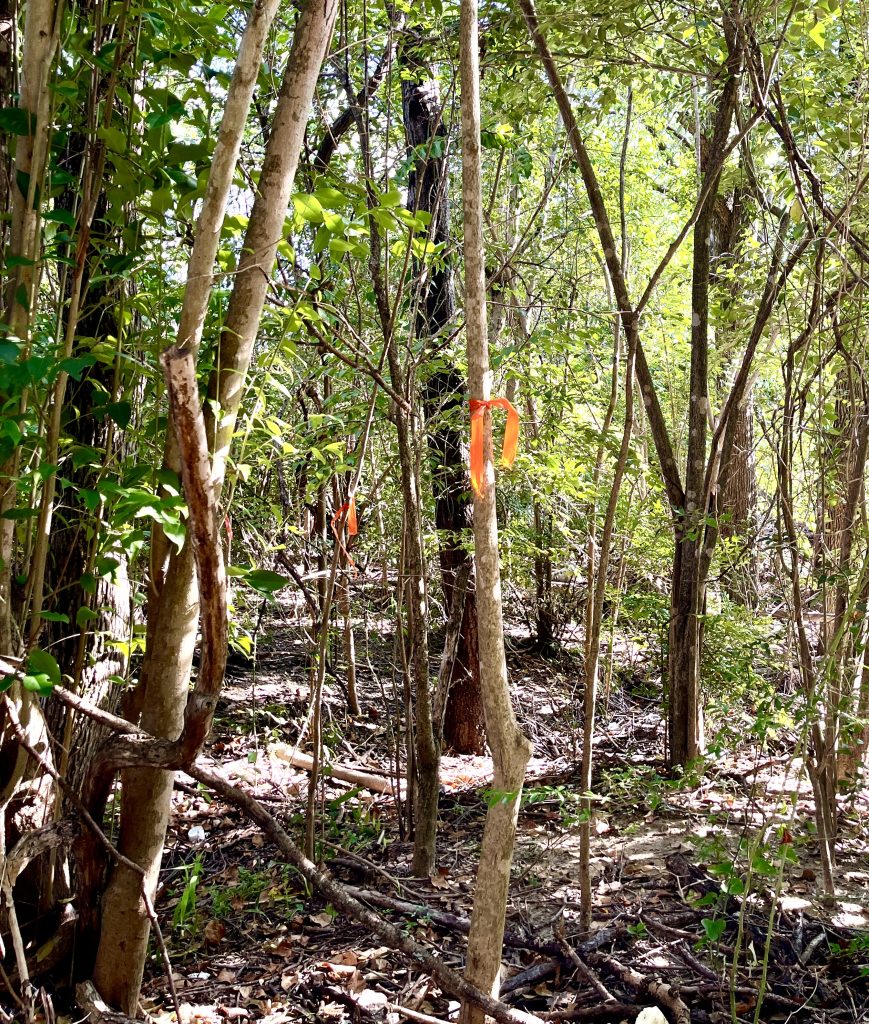
Context: Just after the Main Meadow Trail bends, the Woods Trail splits off to the right and immediately disappears into a wildly enthusiastic patch of river oats that overgrown with Amur honeystuckle, callery pear, Chinese pistache, and Chinese privet. Then it turns to follow the creek. But the creek section of the bank is collapsing, so part of the trail must be moved inward by several feet. It’ll rejoin the old Woods Trail at a small grove of young rusty blackhaw viburnum (!) and continue to The Knoll and trail to Bison Beach.
Goal: Widen and stabilize a little-used section of the Woods Trail.
Strategy: Weedeat the trail entrance in the river oats. Remove Amur honeystuckle, callery pear, Chinese pistache, and Chinese and large-leaf privet from the entrance. Reroute trail away from creek by removing several large Amur honeysuckle and privets. Save long straight trunks to make erosion stick-hedge dams to help prevent the new trail from sliding into the creek. Prune to clear existing Woods Trail up to The Knoll.
Time: half workday (4-5 hrs)
Project A#3:
The Knoll/Trail to Bison Beach
Context: While the berm that separates the Main Meadow from the creek is man-made, this rocky spot called The Knoll — the main entrance to the Woods Trail and to Bison Beach — appears to be natural.
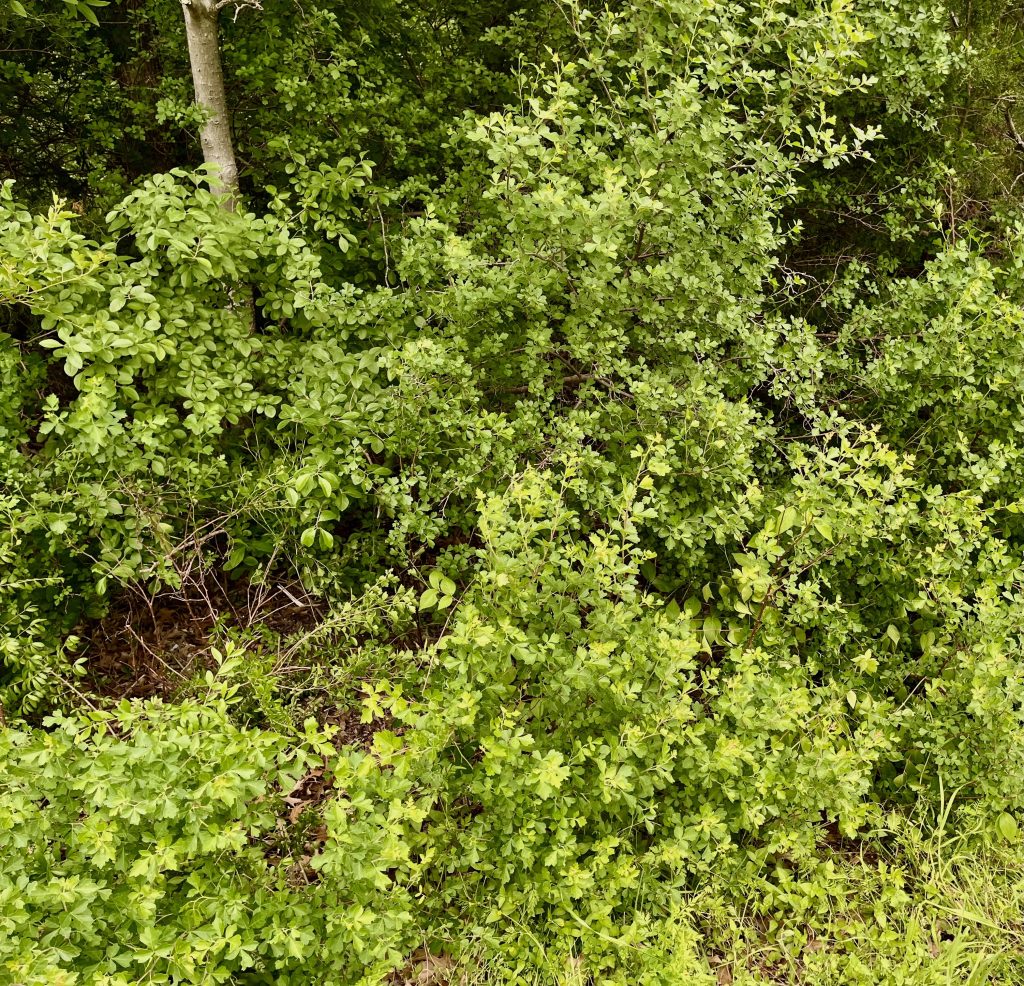
Very large aromatic sumac and elbow bush shrubs, plus an old bois d’arc, hold down the front facing the meadow. These plants indicate this spot has never been bladed.
Behind the knoll is a mini-meadow with a five-foot catalpa planted as a wee sapling two years ago. This is a major drainage off the Main Meadow that will someday be lush and shady.
Notable aspects, goals, & strategy:
- Complete removing privet from the aromatic sumac and elbow bush, started by Katherine Trotter and Amy. The old bois d’arc needs liberation from encroaching greenery.
- Small privet around the catalpa needs a cut and treat.
- Because of the meadow drainage, the trail to Bison Beach needs erosion work, possibly some timber cross-steps, and a rope attached to a tree to help kids access a nicely deep section of the creek.
- Next to The Knoll is an area where a large broken limb was removed. It is now surprisingly sunny and could be seeded with wildflowers or planted with black-eyed Susans and echinacea from Sharon Holmes’ yard.
- The Woods Trail continues east and creates a perfect shady place for a Scout-made bench.
- In front of this area, removing several big large-leaf privet at a prior workday revealed an additional drainage channel. With a little modification, it would make a perfect place for water-loving elderberry shrubs from my yard that I am rooting.
- As the Woods Trail continues east, the berm next to it was cleared of privet and Amur honeysuckle at a prior workday. We have a large supply of pea-sized berries from saw palmettos, a short bushy neotropical palm, from Michael Parkey’s yard. This fall, the berm could be thickly planted to create a stunning display.
So much potential to be stunning here!
Time: full workday (8 hrs) plus lunch break
Project A#4:
Rusty Blackhaw Viburnum Grove
Context: Rusty blackhaw viburnum (RBV) is a superb but rarely found native understory shrub named for its rusty buds and red seasonal color. We have over two dozen! From young ones just finger width to older ones six inches in diameter with cool alligator bark that make big umbrels of ivory blooms in spring. They are struggling to survive an Amur honeysuckle infestation.
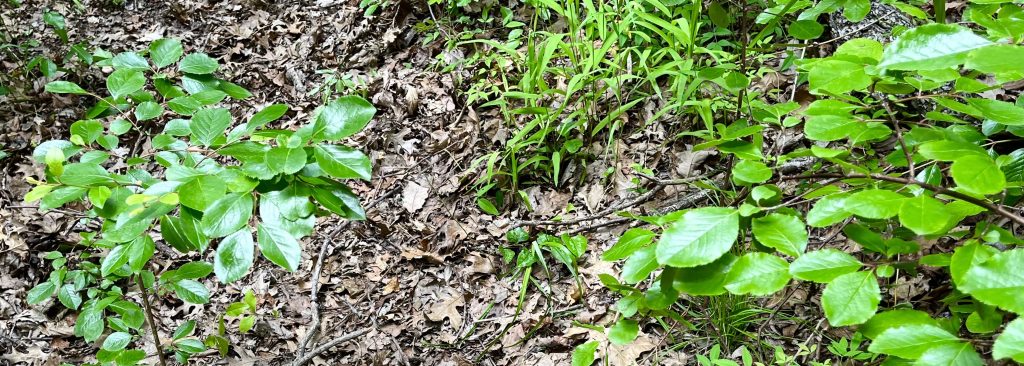
The RBVs are keeping company with some yaupon and coralberry shrubs, plus big chinkapin and Shumard oaks, several cedar elms, a few American elms, two old bois d’arcs, and one box elder, all from 50 to 80+ years old.
Goal: Rescue the RBVs at the wild heart of the Woods Trail and enhance forest diversity.
Strategy: Finish work started by Chris Lane and Amy to remove Amur honeysuckle and privet around the RBVs. We’ll use cut trunks of larger privet to create erosion dams to help prevent the trail from sliding into the creek. Continue to treat poison ivy. Add saplings and mast (acorn, black walnut, and native pecan) for forest diversity. Seed with shade-loving grasses like river oats and Virginia wildrye, and wildflowers like elephant’s foot and Mexican petunia.
Time: half workday (4-5 hrs)
B-list projects from west to east:
Project B#1:
Cedar Elm Grove
Context: On Creekmere near the intersection of Overglen is a grove of a half-dozen mature cedar elms. Because the park department avoids the trees so as not to damage the bark with mowers, Amur honeysuckle and Chinese privet have grown up around the tree bases. Bad for the health of the trees and looks tacky. Ideally, there would be a cover of river oats and Virginia wildrye beneath the cedar elms, but seeds scattered here just wash downhill, all the way to the creek where they’re doing great.
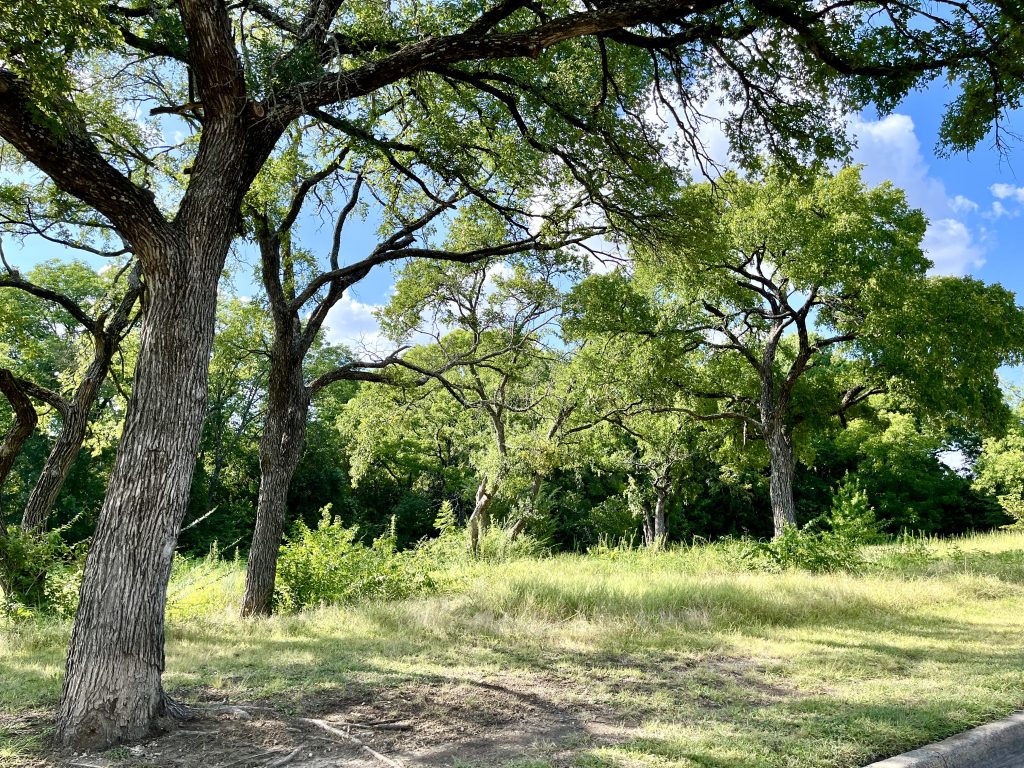
Goal: Liberate and beautify the cedar elms.
Strategy: Remove the Amur honeysuckle and Chinese privet. In the fall, plant some river oats dug out of people’s yards and hope they spread.
Time: 2 mini workdays (2 hrs)
Project B#2:
Pecan Alcove
Context: At the west end of the Main Meadow at the entrance to the Hidden Meadow is another triangular plot anchored by 80+ year-old historic pecan right next to Creekmere. It’s accompanied by a healthy stand of roughleaf dogwood. Next to the pecan was a two-story eastern red cedar that lost its top in windstorms. Now the formerly shady area is partly sunny.
Goal: Create another triangular shady showplace next to Creekmere anchored by a historic pecan, great potential as a bird-nesting area (maybe even with added birdhouses) and a quiet place to sit.
Strategy: Remove privet beneath pecan and around roughleaf dogwood so that it can spread. Seed a mix of tall pokesalad, rosinweed, and frostweed between dogwood and trail to Hidden Meadow to suppress the poison ivy. Pull out larger broken cedar remnants from beneath pecan. Seed beneath with native grasses and wildflowers, and plant beautyberry, coralberry, and pigeonberry.
Time: half workday (4-5 hrs)
Project B#3:
Hidden Meadow
Context: From the historic pecan to Vinemont is a strip of woods along Creekmere that screens a small meadow of poison ivy and invasive KR bluestem. The meadow was seeded with river oats and Illinois bundleflower that suppressed the unwanted plants, plus some tall goldenrod resurged on its own. But it is getting overgrown with saplings and big-leaf privet is moving in from the woods along the street. Keeping it as a meadow benefits armadillos, birds, and rabbits.
Goal: Restore the meadow aspect of the Hidden Meadow.
Strategy: Cut and treat saplings and invasive privet.
Time: mini workday (2-3 hrs)
Project B#4:
Pecan Savannah
Context: A mini-meadow at Creekmere and Vinemont got thoroughly seeded with pecan saplings. The back of it toward the creek was taken over by giant ragweed (achoo!) and hedge parsley (maker of obnoxious burs). A mowing of the ragweed revealed a shady grotto (perfect for a picnic table) with an original understory of Virginia wildrye.
Goal: Create a pecan savanna and shady grotto.
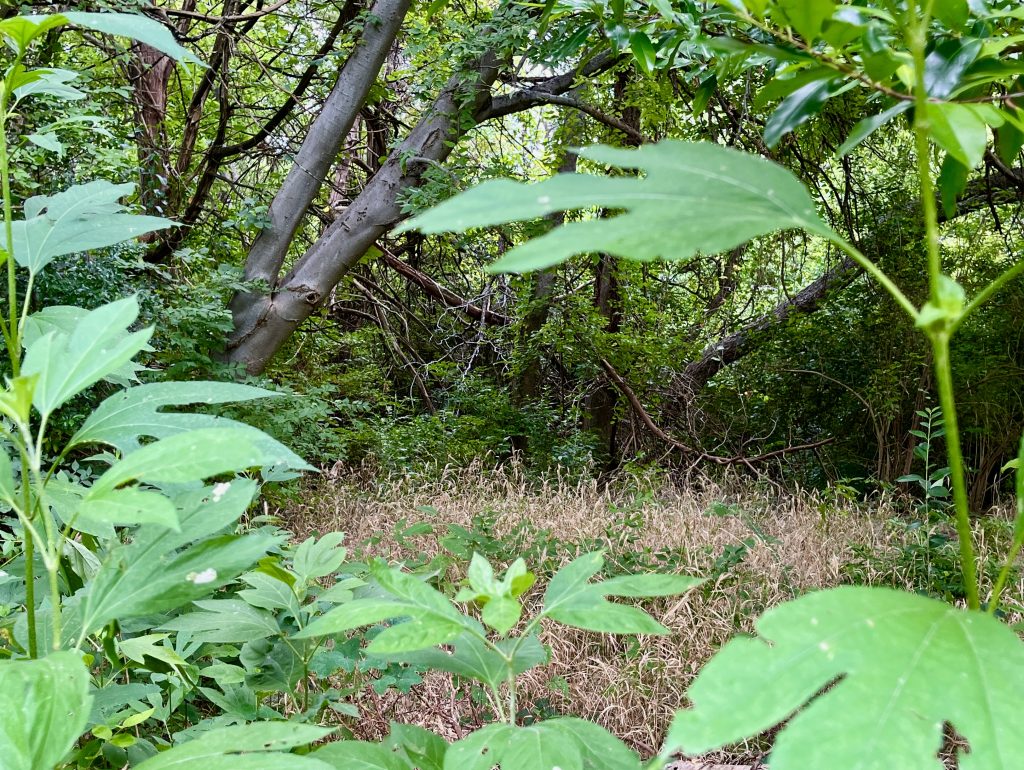
Strategy: Thin out pecan saplings and shape the remainder so they grow into tall trees. Encourage Maximilian sunflowers and other medium-height wildflowers around the pecans by seeding and selective mowing. Keep the giant ragweed and hedge parsley mowed, and overseed area with river oats and Virginia wildrye in fall to try and keep them suppressed.
Time: half workday (4-5 hrs) and maintenance
Project B#5:
Root Ball
Context: Between the Creekmere/Vinemont mini-meadow and Peavy, was the largest tree in the greenbelt — a giant hackberry formed by three saplings growing together. The top half broke off in 2023 Snowmageddon and the tree died. Large limbs continued to fall off. Then the remaining tree toppled, exposing a very interesting root ball visible along the Woods Trail that has mammal burrows. With the new sunlight exposure, the understory of cherry laurel surged. With the abundant fallen timber generating burrowing insects and the cherry laurel berries, it is a bird paradise.
Goal: Make the exposed root ball a visual interest and enhance the area’s wildlife potential.
Strategy: Continue to push back the poison ivy. Stack cut privet across the lower base to better protect the burrows. Remove invading privet and Amur honeysuckle from the cherry laurel grove.
Time: half workday (4-5 hrs)